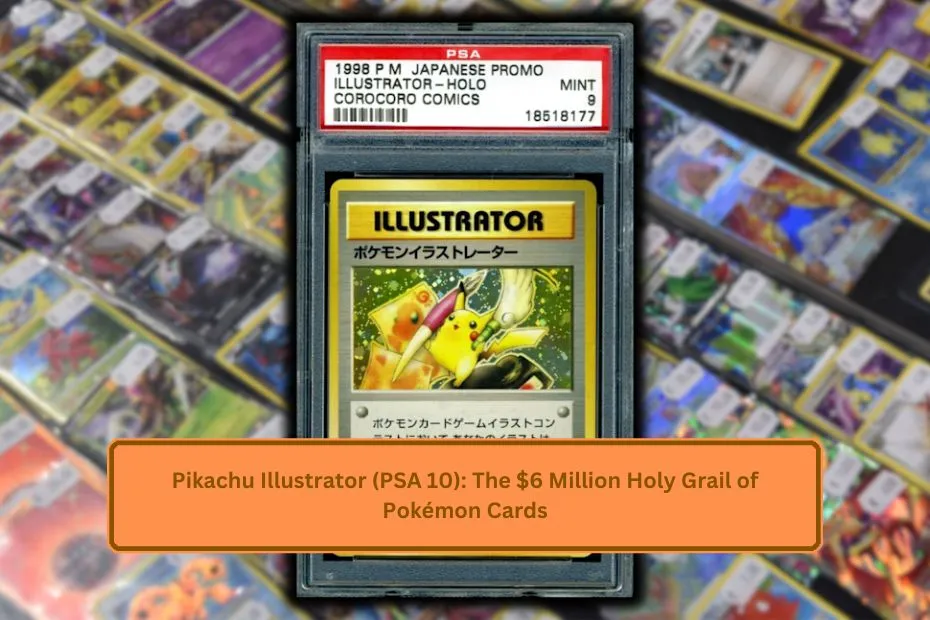In the world of collectibles, few items have sparked as much passion, debate, and transformation as the Pokémon Trading Card Game (TCG). But among thousands of cards printed since the game’s 1996 debut, one card broke all expectations. Selling for over $40,000, this single piece of glossy cardstock ignited a global frenzy and forever changed the way fans, collectors, and investors looked at Pokémon cards. The card in question? The legendary 1998 Pikachu Illustrator card.
The Origins of the Pikachu Illustrator Card
To understand its impact, one must go back to 1997, when CoroCoro Comic, a popular Japanese manga magazine, hosted an art contest. Children across Japan were invited to submit original Pokémon illustrations for a chance to win a unique prize—a card unlike any other.
The prize was not just a rare or shiny Pokémon. It was a hand-picked, tournament-validated Pikachu Illustrator card, officially released in early 1998. Designed by Atsuko Nishida, the original artist behind Pikachu, this card was created as a celebration of art and creativity rather than traditional gameplay. Only 39 copies were believed to have been distributed—though fewer have been verified in the wild.
Why It’s So Special: More Than Just Rarity
The Pikachu Illustrator card holds a number of unique characteristics:
- It’s not part of any set – It stands alone as a promotional item.
- It’s the only card to say “Illustrator” instead of “Trainer” on the top.
- It has a paintbrush-wielding Pikachu, symbolizing the contest theme.
- It was never sold—only awarded, making its ownership even more exclusive.
This card blurs the line between a game piece and a piece of art, elevating its status far above even rare holofoil cards from Base Set or Neo Genesis.
The $40K Sale That Sparked a Movement
In 2016, an authenticated Pikachu Illustrator card in near-mint condition sold at auction for $40,000, shocking even the most seasoned collectors. This sale did more than just break a price record—it transformed how people viewed Pokémon cards.
For many, the card’s sale legitimized Pokémon TCG collecting as an investment class, not just a hobby. News outlets covered the story, drawing attention from Wall Street investors, celebrities, and nostalgic Millennials. The result? A sudden surge in demand for vintage cards, sealed booster boxes, and promotional releases.
The Domino Effect: Pokémon Cards as Assets
After the $40K sale, the collecting landscape shifted dramatically:
| Before 2016 | After the $40K Sale |
|---|---|
| Primarily hobby-based | Hobby + serious investment strategy |
| Limited auction presence | Major auction houses like Heritage and PWCC featured cards |
| eBay sales under $1,000 | PSA 10 cards regularly exceeding $10K |
| Casual collectors dominate | Celebrities and investors join in |
Collectors started grading cards in bulk through PSA, CGC, and Beckett. Rare cards from early sets—particularly 1st Edition Shadowless Base Set Charizard—saw exponential growth in value, reaching six-figure territory. Even modern cards began commanding premium prices if they were low-population PSA 10s or limited print runs.
The Legacy of the Pikachu Illustrator
Today, the Pikachu Illustrator card continues to make headlines. Logan Paul famously wore one during a boxing event in 2022 after purchasing it for over $5 million, making it the most expensive Pokémon card ever sold. While the $40,000 sale was not the highest, it was the first major milestone that proved the Pokémon TCG market had entered a new era.
The card is now:
- A cultural icon, symbolizing the peak of Pokémon collecting.
- A historical relic, linked to the early days of Pokémon fandom.
- A benchmark, against which all other rare cards are measured.
A Symbol of Creativity and Nostalgia
Beyond the monetary value, the Pikachu Illustrator card remains a powerful symbol. It celebrates the imaginative spirit of the fans who drew their favorite creatures on paper, hoping to win a contest. That emotional connection—blending nostalgia, creativity, and rarity—is what makes the card priceless in the hearts of collectors.
It’s not just about what the card is—it’s about what it represents: a pure expression of fandom, and a bridge between childhood joy and adult passion.
Conclusion
The $40,000 Pikachu Illustrator card sale wasn’t just a headline—it was a turning point. It opened doors, ignited passions, and created a blueprint for how the world now views Pokémon cards. It transformed binders into portfolios and childhood memories into tangible assets.
In the end, that $40K price tag represented more than money—it marked the moment Pokémon collecting grew up, without losing its childlike wonder.


